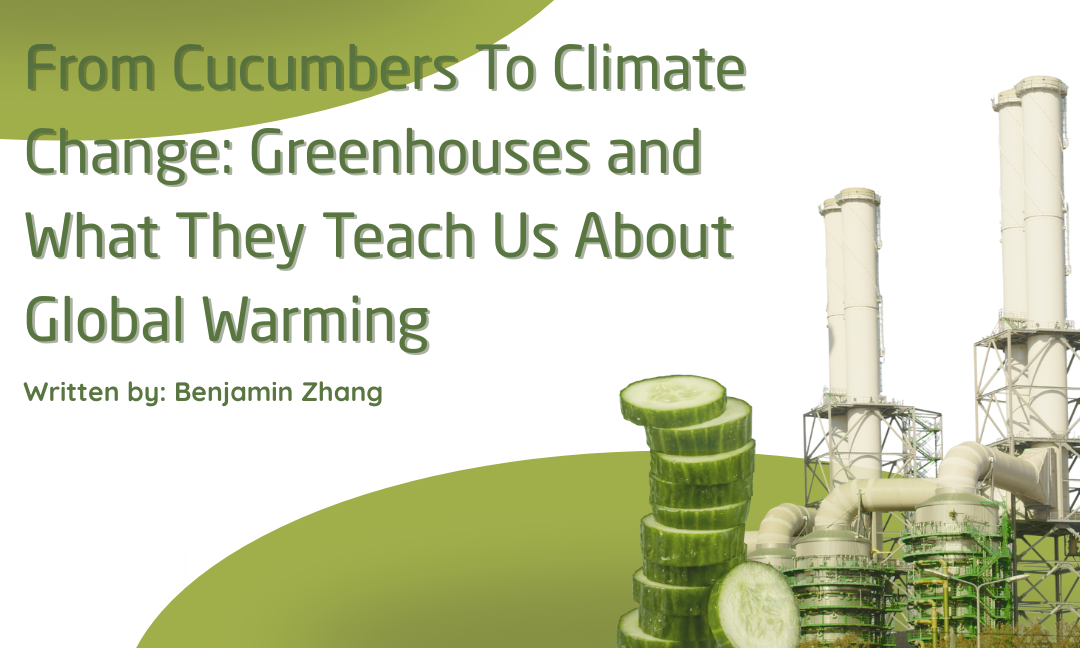Written by: Benjamin Z.
Edited by: Jonathan Lee
Designed by: Andria Sahar
Published by: Rayna Almas
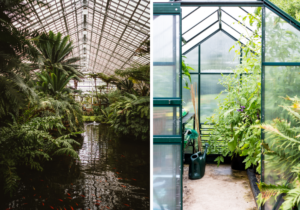
Greenhouse examples
Tropical warmth and thick, moist air greet anyone stepping into a greenhouse, even in the dead of winter. These enclosed spaces, filled with thriving plants and glistening leaves, are the result of centuries of design, adaptation, and scientific understanding. Far more than glass boxes, greenhouses have become vital tools in agriculture, and they offer a way to understand one of the most important phenomena affecting Earth’s climate today: the greenhouse effect.
The concept of greenhouses can be traced all the way back to ancient Rome. Around 30 AD, Emperor Tiberius was prescribed a daily cucumber for his health. To satisfy this medical order, Roman engineers created a structure that used mica, a mineral that allowed sunlight in but retained warmth inside. Over time, this concept evolved. By the Renaissance, glass was replacing mica, and the first structures resembling today’s greenhouses began popping up. These first indoor gardens became essential for cultivating exotic plant species brought back by maritime explorers.
Greenhouses are marvels of modern and ancient agricultural ingenuity, providing a warm, humid space for plants to thrive year-round, regardless of external weather conditions. Their humidity often surprises visitors, but that moist atmosphere is not accidental, it is a direct result of how greenhouses are designed to function. Plants constantly release moisture into the air through a process called transpiration. In an enclosed greenhouse, this water vapour becomes trapped, creating a moist microclimate. Simultaneously, solar radiation enters through the transparent surfaces and warms the interior. As the temperature rises, the air’s capacity to hold water increases, amplifying the humidity. This moist air helps prevent plants from drying out and supports robust growth, but also requires careful regulation to prevent mold or disease.
While the name “greenhouse effect” is derived from these plant-growing structures, the way Earth’s atmosphere traps heat is based on different scientific principles. In a physical greenhouse, sunlight enters through transparent materials such as glass or plastic and warms the interior surfaces. These surfaces then emit infrared radiation (heat), which is not able to pass through the glass as easily as light, causing the heat to remain trapped inside. This process creates a stable, warm environment ideal for photosynthesis and plant development. However, in the atmosphere, the trapping of heat occurs not through solid barriers but through the absorption and re-radiation by certain gases. When sunlight reaches Earth’s atmosphere, much of it passes through the atmosphere and warms the planet’s surface. The surface, in turn, emits this heat in the form of infrared radiation. Greenhouse gases such as carbon dioxide (CO₂), methane (CH₄), ozone (O₃), nitrous oxide (N₂O), water vapour (H₂O), and synthetic compounds like chlorofluorocarbons (CFCs) absorb this ongoing radiation and re-radiate some of it back towards the surface. This natural effect keeps Earth’s average surface temperature around 15°C (59°F), which is essential for maintaining the climate conditions necessary for life. Without it, Earth would be too cold to support most life.
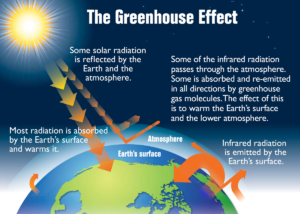
“The Greenhouse Effect” in: “Introduction,” in: US EPA (December 2012) Climate Change Indicators in the United States, 2nd edition[1], Washington, DC, USA: US EPA, p.3. EPA 430-R-12-004.
However, human activity, especially since the Industrial Revolution, has led to a sharp increase in greenhouse gas concentrations. The burning of fossil fuels, deforestation, industrial agriculture, and other practices have released vast amounts of CO₂, CH₄, and N₂O into the atmosphere. These elevated levels are amplifying the natural greenhouse effect, contributing to global warming and climate destabilization. One of the most significant consequences is the rise in average global temperatures, which in turn affects sea levels, weather patterns, and the frequency of extreme weather events.
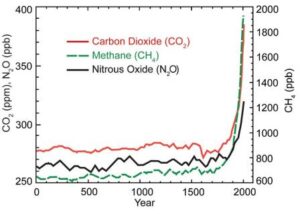
This graph shows the increase in greenhouse gas (GHG) concentrations in the atmosphere over the last 2,000 years. Increases in concentrations of these gases since 1750 are due to human activities in the industrial era. Concentration units are parts per million (ppm) or parts per billion (ppb), indicating the number of molecules of the greenhouse gas per million or billion molecules of air. Source: U.S. National Climate Assessment (2014). https://19january2017snapshot.epa.gov/climate-change-science/causes-climate-change_.html
Water vapour, though not directly emitted by human activity, plays a key role in what is known as a positive feedback loop. As the planet warms due to higher concentrations of greenhouse gases, more water evaporates from both water and land areas. This added water vapour further traps heat, causing even more evaporation. Unlike in a greenhouse, where humidity is intentionally maintained for plant benefit, in the Earth’s atmosphere, rising humidity levels can accelerate warming. This feedback mechanism contributes significantly to climate change and makes controlling greenhouse gas levels even more urgent.
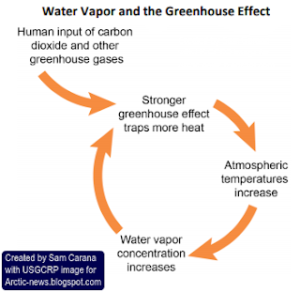
From Moistening Atmosphere: https://arctic-news.blogspot.com/p/moistening-atmosphere.html
This comparison between greenhouses and the atmospheric greenhouse effect reveals important distinctions. Greenhouses are designed for stability, predictability, and control. Their humid interiors are finely tuned ecosystems where temperature and moisture levels support plant health. Earth’s climate system, while robust, is now being pushed beyond its natural thresholds by human actions. The rapid accumulation of greenhouse gases is disrupting the stable balance that has supported life for millennia, with implications not only for global temperatures but also for ecosystems, agriculture, and future generations.
Understanding the science behind both physical greenhouses and the atmospheric greenhouse effect is vital in today’s world. One teaches us how to grow food more effectively and extend growing seasons, while the other warns about the consequences of disrupting Earth’s natural balance. In essence, greenhouses are humid because that humidity is part of a carefully managed environment designed to promote plant life. Earth’s atmosphere is also part of a system, but one we must now manage with extreme care if we hope to preserve the delicate equilibrium that has made life possible. The science is clear, and just as ancient engineers once manipulated light and heat to grow cucumbers for an emperor, we must now use our knowledge to protect a planet that is warming faster than ever before.
References
Agritecture. (n.d.). Growing More With Less: The Past, Present and Future of Greenhouses. Agritecture. https://www.agritecture.com/blog/2019/5/7/growing-more-with-less-the-past-present-and-future-of-greenhouses#:~:text=Maybe%20not%20so%20surprisingly%2C%20the,such%20as%20orange%20and%20pineapple
art@vulcansonco.com. (2024, April 23). How Do Greenhouses Work? Understanding How They Function! Vulcan Plastics. https://www.twpolycarbonate.com/how-do-greenhouses-work-understanding-how-they-function/#:~:text=Operational%20Mechanics%20of%20Greenhouses,thus%20stabilizing%20the%20internal%20temperature
Belt, H. (2023, June 26). Greenhouse humidity control | Avoid excessive humidity. Royal Brinkman. https://royalbrinkman.com/knowledge-center/technical-projects/greenhouse-humidity-control
Climate Science Investigations (CSI). (2023, March 4). The Greenhouse Effect. Climate Science Investigations (CSI). https://www.ces.fau.edu/nasa/module-2/how-greenhouse-effect-works.php
Denchak, M. (2022, May 23). Are the Effects of Global Warming Really that Bad? NRDC. https://www.nrdc.org/stories/are-effects-global-warming-really-bad
Government of British Columbia. (2015, July). Understanding Humidity Control in Greenhouses. Government of British Columbia. https://www2.gov.bc.ca/assets/gov/farming-natural-resources-and-industry/agriculture-and-seafood/animal-and-crops/crop-production/understanding_humidity_control.pdf
Government of Canada. (2025, January 21). Statistical Overview of the Canadian Greenhouse Vegetable and Mushroom Industry 2023. Government of Canada. https://agriculture.canada.ca/en/sector/horticulture/reports/statistical-overview-canadian-greenhouse-vegetable-and-mushroom-industry-2023
Matt. (2021, January 6). How Greenhouses Work. South West Greenhouses. https://www.swgreenhouses.co.uk/blog/how-greenhouses-work.html
Meir, R. (n.d.). Greenhouse Humidity – Manage Moisture For Improved Quality and Yields. Grow Files. https://growmag.com/grow-files/greenhouse-humidity/#:~:text=Plant%20Transpiration%20Makes%20Greenhouses%20Extremely,in%20order%20to%20stay%20active
NASA. (2022, February 8). Steamy Relationships: How Atmospheric Water Vapor Amplifies Earth’s Greenhouse Effect. NASA. https://science.nasa.gov/earth/climate-change/steamy-relationships-how-atmospheric-water-vapor-amplifies-earths-greenhouse-effect/
NASA. (2024, October 23). What is the greenhouse effect? NASA. https://science.nasa.gov/climate-change/faq/what-is-the-greenhouse-effect/
The Ohio State University. (2017, February). Greenhouse Gurus. OSU.EDU. https://u.osu.edu/greenhousegurus/background-research/history/

